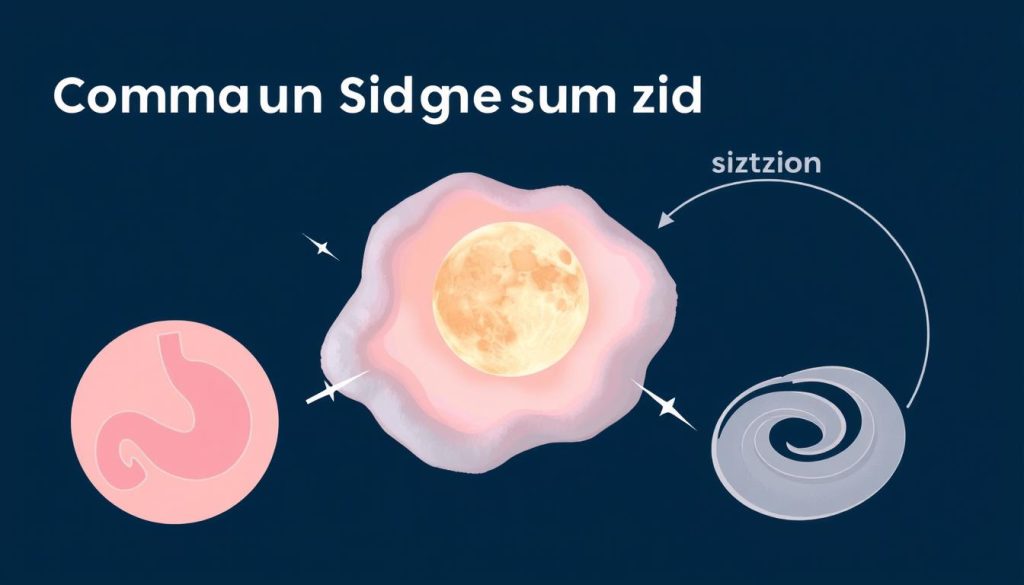Magnesium oxide supplements help prevent and fix low magnesium levels in the blood. It’s important to know about the mag oxide safety profile for good health. Today, we’re looking at mag oxide and its possible side effects.
Magnesium oxide supplements are everywhere, showing their importance. But we need to talk about mag oxide side effects. This guide is for you, whether you’re starting supplements or checking your mineral intake. It’s all about helping you stay healthy.
Understanding Mag Oxide and Its Uses
Magnesium oxide, or mag oxide, is a mineral supplement. It helps manage low blood magnesium levels and other health issues. It’s key for muscle and nerve function and blood pressure regulation. This section explains the main mag oxide uses and the magnesium oxide benefits.
Magnesium oxide is vital for treating magnesium deficiency. This condition can cause serious health problems if not treated. Magnesium is needed for over 300 body functions. Without enough, people may feel tired, have muscle cramps, and face severe neurological issues.
- Improvement of digestion
- Prevention of magnesium deficiency
- Relief from heartburn and indigestion
- Neutralization of stomach acid
Magnesium oxide is often chosen because it’s well absorbed. It helps with heartburn and constipation, making it a common over-the-counter choice. It also helps with muscle recovery and reduces migraine frequency. This makes it a versatile supplement for many health issues.
Mag oxide uses extend beyond health supplements. It’s used in agriculture to improve soil and in industry as a refractory material. These uses take advantage of magnesium oxide’s chemical properties, showing its wide range of applications.
While the magnesium oxide benefits are many, it’s important to talk to a healthcare provider before starting it. They can ensure the supplement fits your specific needs and health conditions.
Common Side Effects of Magnesium Oxide
It’s important to know about the side effects of magnesium oxide when using supplements or medications. This part talks about the different bad effects, from mild to serious. It also looks at the differences between over-the-counter (OTC) and prescription-strength versions.
Minor Digestive Issues
Many people experience mild stomach problems as mag oxide side effects. These can include:
- Nausea
- Vomiting
- Diarrhea
- Stomach cramps
These symptoms often happen right after starting the supplement. They might get better as your body gets used to it.
Over-The-Counter vs. Prescription Variants
The strength of magnesium oxide changes a lot between OTC and prescription types. This affects how likely and how bad side effects can be. OTC versions are for mild needs and usually cause fewer side effects. But, prescription-strength is for more serious needs and can cause more serious side effects.

Knowing these differences is key for managing side effects of magnesium oxide when treating health issues. Always talk to a healthcare provider about any concerns. They can give advice that fits your health needs and how you’re using magnesium oxide.
Mag Oxide Side Effects on Kidney Health
The mag oxide safety profile is usually good for most people. But, it’s different for those with kidney problems. This part looks at how mag oxide can harm kidneys and the risks it brings.
People with kidney issues can’t get rid of magnesium as well. This can cause too much magnesium in the body. It’s important to know the signs of this to avoid harm.
- Elevated magnesium levels in blood tests
- Decreased urine output
- Nausea and vomiting
- Lowered blood pressure
- Irregular heartbeat
It’s key to watch closely and get medical help if needed. If mag oxide is used, doctors must carefully adjust the dose. This helps keep it safe for the body.
Watching kidney health and mag oxide’s effects is vital. It’s not just a precaution. It’s a way to protect your health when your kidneys are not working right.
Potential Allergic Reactions to Mag Oxide
Mag oxide is often used to treat different health issues. But, some people might have allergic reactions to it. These reactions can be mild or severe. It’s important for users to know about these reactions and how to handle them.
Recognizing Allergic Symptoms
It’s key to spot allergic signs early when using magnesium oxide. Symptoms include hives, skin redness, itching, trouble breathing, and swelling. Spotting these side effects early can help avoid worse problems.
If you notice these symptoms, think about if mag oxide use caused them. For more info on symptoms, check out HealthWith. It lists symptoms related to different substances.
Immediate Steps to Take if Allergic Reaction Occurs
If you think you’re having an allergic reaction to mag oxide, stop using it right away. Then, talk to a doctor. If the reaction is severe or you can’t breathe well, call for emergency help.
Acting fast and knowing what to do can lessen the risks of allergic reactions to mag oxide. Always have emergency numbers and allergy meds ready if you have allergies.
Interactions with Other Medications
It’s important to know about mag oxide interactions if you take this supplement. It can change how well other medicines work. This is true for magnesium oxide supplement interactions with many drugs.
Magnesium oxide can stop some antibiotics and treatments for osteoporosis from working right. This can make them less effective. Here, we’ll look at common interactions and how to handle them.
| Medication Type | Interaction with Mag Oxide | Management Suggestion |
|---|---|---|
| Bisphosphonates | Reduces absorption | Take bisphosphonates at least two hours before mag oxide |
| Antibiotics (e.g., Tetracycline, Quinolones) | Decreases antibiotic absorption | Separate doses by at least two to three hours |
| Diuretics (Thiazide type) | Increases magnesium excretion | Monitor serum magnesium levels regularly |
Talking to a healthcare professional is a good idea. They can help you plan your medication schedule. This way, you can avoid problems from magnesium oxide supplement interactions.
- Always check with your healthcare provider before starting new medications alongside magnesium oxide.
- Periodic monitoring of drug levels may be necessary to adjust doses for effectiveness.
- Patient education regarding symptoms of drug-magnesium interference is critical for managing side effects proactively.
By following these tips, you can reduce the chance of mag oxide interactions. This helps keep all your medicines working well.
How to Use Mag Oxide Supplements Safely
It’s important to know how to use mag oxide supplements safely. This ensures you get the most benefits without risks. We’ll cover the right mag oxide dosage and when to see a doctor.
Understanding Correct Dosage
The right amount of magnesium oxide varies by person. It usually ranges from 250 to 500 mg daily. But, some health issues might need different amounts. This is why getting advice from a doctor is key.
When to Consult a Healthcare Professional
You should talk to a doctor if you’re pregnant, have kidney problems, or take other medicines. A doctor can help you use mag oxide supplements safely. They’ll make sure the dosage fits your health needs and other treatments.

Starting with a small dose and slowly increasing it can help avoid side effects. This is another important thing to talk about with your doctor.
Mag Oxide Benefits and Risks: A Balanced View
It’s important to know the mag oxide benefits and risks before taking this supplement. Magnesium oxide helps with low magnesium levels and can ease constipation, heartburn, and indigestion. But, it’s also key to understand its side effects to make smart health choices.
Magnesium oxide has many uses, from boosting magnesium levels to easing stomach problems. For more on its benefits, click here.
- Benefits: It helps prevent magnesium deficiency, which is vital for muscle and nerve health, a strong immune system, and blood pressure control.
- Risks: Knowing the magnesium oxide side effects is critical. These can include nausea, cramps, or diarrhea. Too much can cause serious problems like an irregular heartbeat or low blood pressure.
To weigh the mag oxide benefits and risks properly, talk to a healthcare provider. They can help find the right magnesium treatment for you. This ensures it helps your health without causing harm.
Risks of Long-Term Mag Oxide Use
Magnesium oxide is good for quick relief and as a supplement. But, it’s important to think about its long-term effects on your health. Over time, your body might get used to it, making it less effective. This could mean you need more of it to feel the same benefits.
Assessing Tolerance Over Time
Using magnesium oxide for a long time means you should check how well it works often. People taking it for a long time should watch how their body reacts. If you start needing more to feel the same relief, it’s a sign of tolerance. This is important for managing your treatment over time.
Monitoring Health Markers and Lab Results
It’s key to check your health regularly with lab tests if you’re taking magnesium oxide for a long time. These tests show if there are any changes in your body that could be bad. For example, they can check if your electrolyte balance or kidney function is off.
| Health Marker | Baseline | 3 Months | 1 Year |
|---|---|---|---|
| Magnesium Level | 0.85 mmol/L | 0.90 mmol/L | 0.88 mmol/L |
| Renal Function | Normal | Normal | Monitor |
| Electrolyte Balance | Stable | Stable | Check Sodium |

It’s important to keep an eye on these key areas to manage the risks of using magnesium oxide for a long time. Doing this with the help of a healthcare professional is key. It helps make sure your magnesium oxide therapy is safe and working well.
Identifying Signs of Mag Oxide Toxicity
Knowing the signs of mag oxide toxicity is key to getting help fast. This part talks about important symptoms of magnesium oxide overdose. It helps you spot these signs in yourself or others. Spotting them early can lessen the bad effects of too much.
Watch For: Here are several key indicators of mag oxide toxicity:
- Nausea and Vomiting
- Severe Hypotension (low blood pressure)
- Respiratory distress
- Lethargy or profound drowsiness
- Muscle weakness
- Irregular heartbeat
If you see any of these magnesium oxide overdose symptoms, get help right away. Waiting can make things worse and lead to serious health problems. Here’s a detailed list of risks from too much magnesium oxide.
| Symptoms | Potential Complications | Immediate Actions |
|---|---|---|
| Nausea and Vomiting | Dehydration, Electrolyte Imbalance | Contact healthcare provider |
| Severe Hypotension | Shock, Organ Failure | Emergency medical services |
| Respiratory Distress | Decreased Oxygen Levels, Risk of Hypoxia | Emergency medical services |
| Lethargy or Drowsiness | Impaired Cognitive Functions | Monitor and consult a doctor |
| Muscle Weakness | Difficulty in Physical Activities | Seek immediate medical advice |
| Irregular Heartbeat | Cardiac Risk | Immediate clinical evaluation |
Learning about mag oxide toxicity helps you stay safe. It lets you act fast if you see signs of an overdose.
Mag Oxide Dosage: How Much is Too Much?
Knowing the right mag oxide dosage is key for doctors and patients to avoid magnesium oxide overdose. By comparing official guidelines with personal tolerance, people can find the best amounts to take.
Official Guidelines vs. Personal Tolerance
Official dosing advice comes from lots of research and studies on big groups of people. These rules help keep most people safe and effective. But, everyone’s body is different, so some might need to change their dose with a doctor’s help. Finding the right balance between following the rules and listening to your body is important for magnesium oxide overdose prevention.
The Role of Individual Metabolism
How fast your body breaks down magnesium oxide can change based on your metabolism. Things like age, kidney health, and other health issues can affect your metabolism. Knowing about your metabolism can help you adjust your mag oxide dosage to get the most benefits without too much.
| Factor | Influence on Dosage |
|---|---|
| Age | Older adults might need lower dosages due to slower metabolism |
| Kidney Function | Poor kidney function can lead to higher blood levels of magnesium oxide, requiring dosage adjustments |
| Health Conditions | Conditions like gastrointestinal disorders can alter magnesium absorption and retention |

Adverse Effects of Mag Oxide on Gastrointestinal Health
Magnesium oxide helps with many health issues but can harm your stomach. Knowing how it affects your digestion is key to avoiding these problems.
Magnesium oxide is usually safe when taken right. But too much can cause stomach issues. This happens because it pulls water into your intestines. This can cause mild to severe symptoms.
- Diarrhea: This is the most common symptom due to the laxative property of magnesium oxide.
- Abdominal Cramping: An increase in intestinal water can lead to pain and cramping.
- Nausea: Many individuals report feeling nauseous, specially when doses are taken on an empty stomach.
| Symptom | Typical Onset | Management Tips |
|---|---|---|
| Diarrhea | 1-3 hours after ingestion | Reduce dosage, take with food |
| Abdominal Cramping | Within a few hours | Lower dose, consider time-release formulations |
| Nausea | 1-2 hours after ingestion | Take with meals, hydrate well |
Managing the gastrointestinal side effects of magnesium oxide often means adjusting how much you take and when. But, if you keep getting sick or it hurts a lot, talk to a doctor. This way, you can enjoy the benefits of mag oxide without harming your stomach.
Mag Oxide Safety Profile for Different Populations
It’s important to know about magnesium oxide safety considerations, which is true for different groups of people. Mag oxide for various populations needs a special approach to be safe and effective. Let’s look at how mag oxide affects different groups.

- Pregnant Women: Magnesium oxide helps with constipation and leg cramps during pregnancy. But, always talk to a doctor first to avoid too much.
- The Elderly: Older people might face more risks from magnesium oxide because of other medicines they take. It’s also key to watch their kidneys.
- Individuals with Chronic Conditions: People with kidney disease need to be careful with magnesium oxide. It’s best to use it only with a doctor’s watchful eye to avoid too much.
When it comes to magnesium oxide safety considerations, getting advice from a professional is a must. Here’s a table with tips for these groups.
| Population | Monitoring | Usage Tips |
|---|---|---|
| Pregnant Women | Monitor for overdose symptoms | Only use under health professional advice |
| The Elderly | Regular kidney function tests | Assess for drug interactions |
| Individuals with Chronic Conditions | Check magnesium serum levels frequently | Start with lower doses, adjust as needed |
In short, using mag oxide for various populations safely depends on knowing about health conditions. This shows why healthcare should be tailored for each person.
Mitigating the Side Effects of Magnesium Oxide
When you add magnesium oxide to your daily routine, it’s key to reduce side effects through lifestyle changes. A smart approach can make your supplement experience better.
Lifestyle Modifications and Supplement Timing
Choosing the right time to take magnesium oxide is important. Taking it with a meal can help avoid stomach upset. Also, taking it away from other medicines can stop bad interactions.
- Avoid magnesium oxide on an empty stomach to lessen digestive issues.
- Consider evening administration if daytime dosing causes discomfort.
Changing your daily habits can also help. Regular exercise and stress management can make your body use magnesium better. This can reduce side effects.
Importance of Hydration and Dietary Considerations
Drinking enough water is key when taking magnesium oxide. It helps avoid constipation and keeps your digestive system healthy. A well-hydrated body absorbs magnesium supplements better.
- Drink at least 8-10 glasses of water throughout the day.
- Include fiber-rich foods in your diet to enhance digestive health.
What you eat also matters. Foods high in magnesium, like almonds and spinach, can help your body. They balance your mineral levels, making supplements work better.
Navigating the Complexities of Mag Oxide Interactions
It’s key to know how mag oxide interacts with other things when taking magnesium oxide supplements. This includes prescription drugs, over-the-counter meds, and some foods. Knowing how to mix magnesium oxide with other supplements is important to avoid bad side effects and get the health benefits you want.
Magnesium oxide can change how some prescription drugs work. For instance, it might make some antibiotics less effective by binding to them. People taking drugs for osteoporosis or heart issues need to be extra careful. This is because mag oxide can affect how these drugs work. Always talk to a doctor before starting magnesium oxide, so they can help avoid any bad interactions.
Also, watch out for interactions with over-the-counter medicines and foods rich in minerals like calcium or phosphorus. Too much of these can be harmful. Being open with your doctor about what you eat and take as supplements is important. This way, they can give you advice tailored to your needs, making sure magnesium oxide is safe and effective for you.
FAQ
Q: What are common side effects of magnesium oxide supplements?
A: Taking magnesium oxide can sometimes cause minor stomach problems. These include nausea, vomiting, diarrhea, and stomach cramps.
Q: Can mag oxide affect kidney health?
A: Yes, mag oxide can harm the kidneys, mainly if you already have kidney issues. It can build up and be toxic. Always watch your kidney health if you’re taking these supplements.
Q: What immediate steps should be taken if an allergic reaction to mag oxide occurs?
A: If you have an allergic reaction to mag oxide, like hives or trouble breathing, get help right away. Go to the emergency room.
Q: How can mag oxide interact with other medications?
A: Mag oxide can change how other medicines work. This includes drugs like bisphosphonates and antibiotics. Always talk to a doctor about possible interactions.
Q: What is the correct dosage for mag oxide supplements and when should a healthcare professional be consulted?
A: The right amount of mag oxide depends on your health and the product’s instructions. Always talk to a doctor before starting supplements. They can give you the best dosage for you.
Q: What are the risks and benefits of using mag oxide?
A: Mag oxide can help with magnesium deficiency and symptoms like heartburn. But, it can also cause stomach issues and interact with other medicines. Too much can be toxic.
Q: What should be considered when using mag oxide supplements over a long term?
A: Long-term use needs careful monitoring. Watch your body’s reaction and health markers. Regular check-ups with your doctor are key to staying safe.
Q: What are signs of mag oxide toxicity to watch out for?
A: Signs of toxicity include low blood pressure, nausea, and trouble breathing. If you think you have toxicity, get medical help fast.
Q: How do official guidelines for mag oxide dosage compare with personal tolerance?
A: Official guidelines are a starting point for safe dosages. But, everyone’s body is different. Always follow your doctor’s advice and get personalized guidance.
Q: Are there adverse effects of mag oxide on gastrointestinal health?
A: Yes, mag oxide can cause stomach problems like cramps and diarrhea. It can also rarely cause bowel obstruction. Be careful, and watch out for these side effects, mainly with high doses.
Q: What should be considered regarding mag oxide safety across different populations?
A: Safety with mag oxide varies by group. Pregnant women, the elderly, and those with chronic conditions should be extra careful. Always use it under a doctor’s watch.
Q: How can side effects of magnesium oxide be mitigated?
A: To lessen side effects, try lifestyle changes. Take your supplement at the right time, drink plenty of water, and eat foods that help magnesium absorption.
Q: What is important to understand about navigating mag oxide interactions?
A: Knowing about mag oxide interactions is key to avoiding problems. Talk to your doctor about possible interactions and follow their advice closely.


















